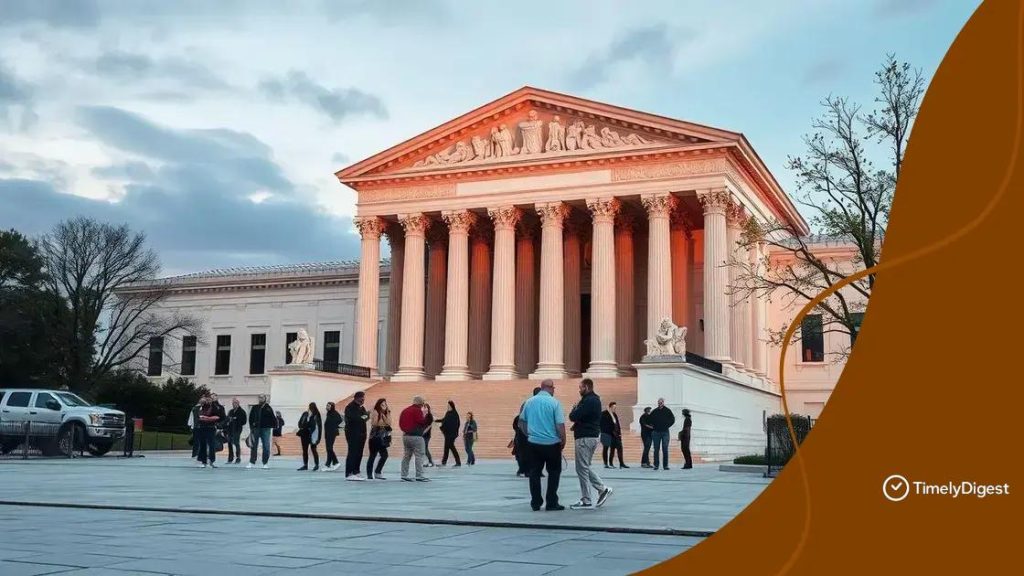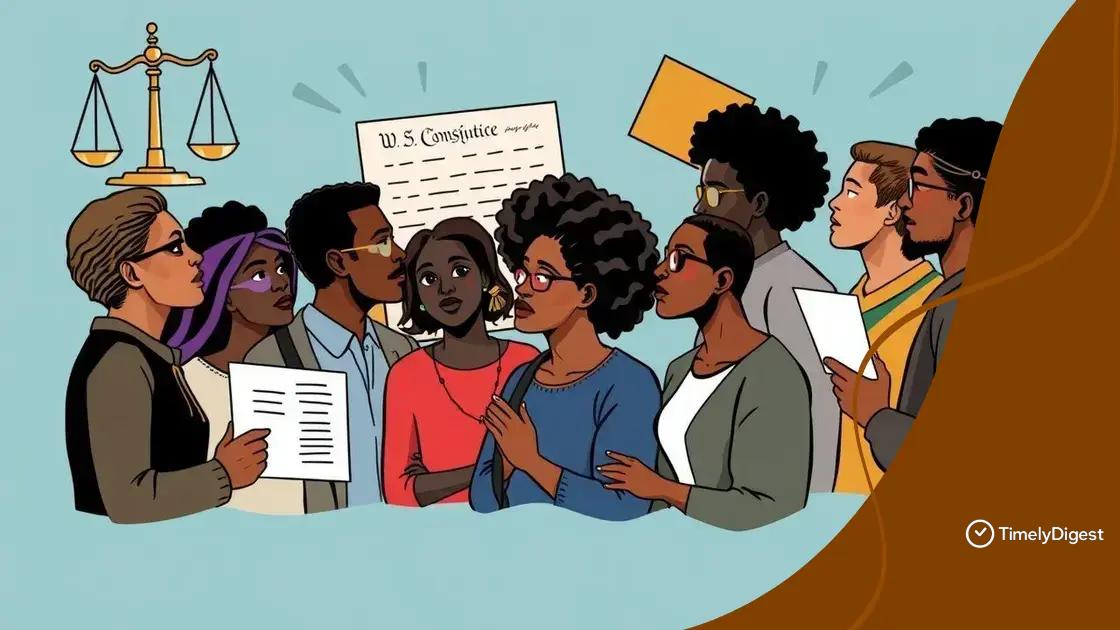Supreme Court rulings: what you need to know

Anúncios
Supreme Court rulings significantly impact individual rights and societal values, shaping laws on issues like voting rights, reproductive rights, and technology as public opinion continues to influence judicial decisions.
Supreme Court rulings impact all of us, often in ways we don’t realize. Have you ever wondered how these decisions shape your rights and everyday life? Let’s dive into their significance.
Anúncios
Understanding the significance of Supreme Court rulings
Understanding the significance of Supreme Court rulings is crucial for anyone interested in the legal landscape of the United States. These rulings do not just influence the law; they also impact everyday lives, often in unexpected ways.
The role of the Supreme Court
The Supreme Court serves as the highest court in the land. It interprets the Constitution and has the final say on legal disputes. Through its various decisions, the Court defines the boundaries of individual rights and government powers.
Key aspects of Supreme Court rulings
When we talk about the significance of these rulings, several key aspects come to mind:
Anúncios
- Legal Precedent: Supreme Court decisions create lasting legal precedents that lower courts must follow.
- Impact on Society: Many rulings address issues like civil rights, healthcare, and education, shaping societal norms.
- Public Awareness: High-profile cases often lead to increased public interest and engagement in legal matters.
For instance, landmark decisions like Brown v. Board of Education changed the face of education forever. This case underscored the importance of equality in public schooling. It also set a powerful precedent for future rulings addressing civil rights.
Understanding these rulings allows citizens to grasp their own rights better. Knowledge of legal precedents can empower individuals in legal situations. When you know your rights, you can advocate for yourself more effectively.
How rulings affect daily life
Every day, Supreme Court rulings influence people’s lives. From employment rights to free speech, these decisions provide a framework for legal standards. Just think about marriage equality; the ruling in Obergefell v. Hodges made legal same-sex marriage across the country.
In essence, the ripple effect of Supreme Court decisions can be felt in numerous aspects of life, including how laws are interpreted and enforced. They create pathways for change and often pave the way for future legislation.
Key Supreme Court decisions that changed history
Key Supreme Court decisions have shaped the course of American history in many ways. Understanding these pivotal rulings is essential for grasping their impact on society.
Landmark rulings that transformed rights
Throughout history, the Supreme Court has made decisions that affirmed and expanded individual rights. For example, the ruling in Roe v. Wade (1973) established a woman’s right to choose, setting a precedent for reproductive rights.
Another significant case, Brown v. Board of Education (1954), struck down racial segregation in public schools. This ruling was crucial in the fight for civil rights, illustrating the power of the Court to effect change.
Impact on social justice
These rulings not only define legal standards; they also reflect societal values. The Obergefell v. Hodges (2015) decision legalized same-sex marriage nationwide, marking a victory for LGBTQ+ rights.
- Roe v. Wade: A landmark decision on reproductive rights.
- Brown v. Board of Education: Ended segregation in schools.
- Obergefell v. Hodges: Legalized same-sex marriage across the U.S.
- Miranda v. Arizona: Established Miranda rights, enhancing protection for those in custody.
In addition, the Miranda v. Arizona case (1966) set the precedent for informing suspects of their rights during an arrest. This decision helped ensure fairness in the justice system.
These key decisions illustrate how the Supreme Court’s power influences legislation and public policy. Each case reflects the changing attitudes of society and the ongoing struggle for justice and equality.
How Supreme Court rulings affect your rights

How do Supreme Court rulings affect your rights? This question is essential for understanding the dynamics of the legal system in the United States. Supreme Court decisions play a vital role in shaping our rights and freedoms.
The impact on individual rights
Many rulings determine the scope of personal liberties. For instance, the decision in Miranda v. Arizona established that individuals must be informed of their rights when arrested. This ruling ensures that suspects can exercise their rights against self-incrimination.
Rights protection through landmark cases
Several key rulings have directly influenced everyday rights:
- Roe v. Wade: This decision recognized a woman’s right to choose an abortion, solidifying reproductive rights.
- Obergefell v. Hodges: Legalizing same-sex marriage was a monumental decision that affirmed LGBTQ+ rights.
- California v. Ciraolo: This case addressed privacy rights, establishing limits on government surveillance.
- New Jersey v. T.L.O: This ruling defined students’ rights against unreasonable searches in schools.
Through these decisions, the Supreme Court safeguards various rights that citizens hold dear. These rulings are not just legal formalities; they reflect societal values and norms.
Moreover, the consequences of these decisions can be felt across multiple aspects of life. For example, the Second Amendment interpretations grant individuals the right to bear arms, raising ongoing debates about gun control and safety.
Understanding how these rulings impact rights empowers citizens. Knowing the legal protections available fosters a sense of awareness and advocacy.
Current controversies surrounding Supreme Court rulings
Current controversies surrounding Supreme Court rulings often spark intense discussions and debates. As new cases arise, the implications of past decisions are constantly re-evaluated.
Voting rights issues
One major area of contention is voting rights. The ruling in Shelby County v. Holder (2013) weakened protections against racial discrimination in voting. Many people argue this has led to more restrictive voting laws.
Reproductive rights controversies
Another significant topic is reproductive rights. Since the overturning of Roe v. Wade in 2022, states have enacted various laws affecting abortion access. This has raised questions about women’s rights and health care.
- Challenges to state laws: Some states have passed laws banning abortions after a certain number of weeks.
- Legal battles: Numerous lawsuits have emerged challenging these state laws, creating a patchwork of access across the country.
- Impact on healthcare: These rulings impact women’s health services, increasing anxiety among patients and providers.
Moreover, the Second Amendment discussions around gun rights have intensified after Supreme Court rulings like New York State Rifle & Pistol Association v. Bruen. This decision expanded gun rights, provoking debates over safety and regulation.
As these controversies evolve, public opinion plays a crucial role. Citizens are more engaged than ever in understanding their rights and advocating for changes. Legal experts and lawmakers continue to grapple with the consequences of these rulings, striving for balance between rights and regulations.
The future of the Supreme Court: trends and predictions
The future of the Supreme Court is a topic of great interest and speculation. As societal values shift, predictions about upcoming trends in rulings and decisions are crucial to understanding the court’s direction.
Potential shifts in judicial philosophy
One trend to watch is the potential shift in judicial philosophy. With various justices possibly approaching retirement, future appointments could dramatically change the court’s ideological balance.
Influence of public opinion
Public opinion will continue to play a significant role in shaping the court. As social issues evolve, justices may feel the pressure to align their decisions with the values of the public. This has been evident in recent rulings on topics like abortion and gun control, where societal views have led to contentious debates.
- Changes in public sentiment: The court often reflects shifting societal values, which could impact important rulings.
- Emergence of new legal challenges: Issues such as climate change and technology rights may rise to prominence in upcoming cases.
- Advocacy and Activism: Increased public activism can influence how justices view cases, as seen in recent high-profile societal movements.
Moreover, the impact of technology on law is an exciting development. As society becomes more digital, cases involving privacy and technology will likely take center stage. The Supreme Court may soon need to define rights in the context of the internet more clearly.
As we look forward, the future of the Supreme Court will be shaped not just by the justices themselves but also by the society in which they operate. Understanding these trends is essential for anyone interested in the legal landscape.
The future of the Supreme Court is filled with possibilities. As we discussed, trends like shifts in judicial philosophy and the influence of public opinion will shape important decisions. Key issues such as voting rights, reproductive rights, and technology will continue to redefine our legal landscape. Staying informed about these changes is essential for understanding how they affect our rights. Advocating for justice and equality can help ensure that our legal system reflects the values of our society.
\n
\n
FAQ – Frequently Asked Questions about Supreme Court Rulings
What is the significance of Supreme Court rulings?
Supreme Court rulings shape laws and define citizens’ rights, impacting various aspects of daily life.
How do public opinions influence the Supreme Court?
Public opinions can pressure justices to align their decisions with societal values, leading to changes in rulings.
What are some major issues currently facing the Supreme Court?
Current issues include voting rights, reproductive rights, and the regulation of technology in society.
How can I stay informed about Supreme Court decisions?
You can follow legal news websites, subscribe to legal bulletins, and read summaries from trusted sources to stay up-to-date.